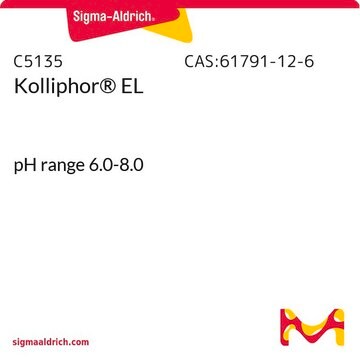50246
Poly(éthylene glycol)-blocage-poly(propylène glycol)-blocage-poly(éthylene glycol)
Synonyme(s) :
Poly(ethylene glycol)-block-poly(propylene glycol)-block-poly(ethylene glycol), Lμtrol micro 127
About This Item
Produits recommandés
Poids mol.
~9840-14600 g/mol
Niveau de qualité
Composition
oxyethylene content, 71.5-74.9%
Impuretés
≤0.25% ethylene glycol and diethylene glycol
≤0.4% total ash
≤0.75% water
≤1 ppm ethylene oxide
≤2 ppm arsenic
≤20 ppm heavy metals
50-125 ppm butylhydroxytoluene
Résidus de calcination
≤0.30%
Couleur
APHA: ≤120
Répartition Des Tailles De Particules
, coeff var ≤10% (residue, No. 140 USS)
, coeff var ≤50% (residue, No. 270 USS)
pH
5.0-7.5(1:10)
5.0-7.5(1:40)
Adéquation
complies for Infrared spectrum
InChI
1S/C3H6O.C2H4O/c1-3-2-4-3;1-2-3-1/h3H,2H2,1H3;1-2H2
Clé InChI
RVGRUAULSDPKGF-UHFFFAOYSA-N
Vous recherchez des produits similaires ? Visite Guide de comparaison des produits
Catégories apparentées
Application
Remarque sur l'analyse
1,4-dioxane ≤5 ppm, ethylene glycol ≤620 ppm ( verified on random samples only)
Autres remarques
Informations légales
Code de la classe de stockage
11 - Combustible Solids
Classe de danger pour l'eau (WGK)
WGK 3
Point d'éclair (°F)
Not applicable
Point d'éclair (°C)
Not applicable
Faites votre choix parmi les versions les plus récentes :
Déjà en possession de ce produit ?
Retrouvez la documentation relative aux produits que vous avez récemment achetés dans la Bibliothèque de documents.
Les clients ont également consulté
Notre équipe de scientifiques dispose d'une expérience dans tous les secteurs de la recherche, notamment en sciences de la vie, science des matériaux, synthèse chimique, chromatographie, analyse et dans de nombreux autres domaines..
Contacter notre Service technique






